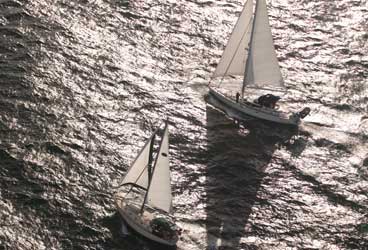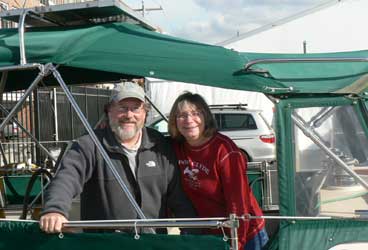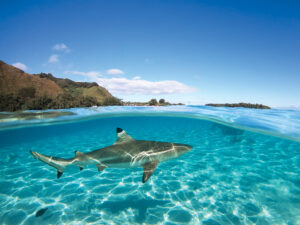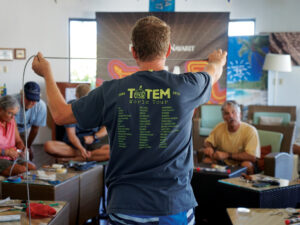
Triple Stars at Start of NARC
The reports from the fleet, southbound in severe North Atlantic weather last November, say it all.
From Bella Luna, a Swan 48:
“So we hunkered down and waited, while monsters crashed the deck and filled the cockpit, drifting at 4 to 5 knots, surfing sideways down waves. We were 86 nautical miles from Bermuda. After seeing the development of Tropical Storm Sean, on Garmin XM Weather, we knew we couldn’t make Bermuda, so we pulled the drogue and aimed for the coast with storm jib alone.”
From Il Sogno, an Oyster 56:
“The storm hit us at midnight with winds 35 to 45 knots and seas from the port quarter that rapidly built to 20 feet. Seas continued to build and became sloppy with swell from the previous nor’easter still in the mix.”
And from Jan Anderson, sailing Triple Stars, an Island Packet 380, with her husband, Rob:
“So far, I must say that the weather has been stinky. The past couple of days have been tough, but we’re hove to and resting today. In talking to our weather guru Herb [Hilgenberg] on the SSB, we’re in good shape, and there are a few boats all spread around this region just hanging out, waiting for this storm/low pressure to pass before we can move any closer to Bermuda. It apparently stalled, producing 40- to 50-plus-knot winds. We’re both good, a little bit tired, but we’ll hopefully both get some sleep tonight. Do not worry—we’re doing fine.”
Sadly, that wouldn’t be the case for long. Aboard Triple Stars, tragedy was just days away.
Rally or Not?
For sailors headed south last November, the North Atlantic was a challenging place to be, especially for the boats that left early in the month, including participants in the 2011 North American Rally to the Caribbean. Last fall’s edition of this annual migration south could be described as a tale of two passages, with some crews doing the 635-mile run between Newport, Rhode Island, and Bermuda in record time while other boats experienced days of sustained gale-force winds, with the seas to match. If this story sounds familiar to you, that’s because it is.
Every year, dozens of boats head south from points along the U.S. Northeast Coast bound for the Caribbean, often planning a stopover in Bermuda. Some choose to go it alone, while others join in the camaraderie and perceived safety of a rally. And most years, the weather plays a major role in the outcome.
In 2011, this was especially true as a series of low-pressure systems produced gale-force winds and even a late-season tropical storm that wreaked havoc on the fleet. The NARC numbers alone can tell the story: Out of 21 boats signed up for the event, 13 made it to Bermuda, two were abandoned, three diverted to the coast for repairs, and several either bypassed Bermuda altogether or took a coastal route. And one crewmember, Jan Anderson from the 38-foot cutter Triple Stars, was tragically swept overboard and lost at sea.
After a two-day weather delay, the NARC boats sailed out of Newport, Rhode Island, on Tuesday, November 1, 2011. They had a tight weather window, and the long-range forecast remained tenuous. At lunch the day before their departure, the Andersons said candidly that they were on the fence about leaving. Ultimately, though, they decided to set forth on the rally.
For the first few days, many boats made good time on a southerly course, which was advised by weather router Susan Genett, in order to cross the Gulf Stream at a narrow point. “We had a glorious sail through the Stream,” said Andy Lippman from the Swan 48_ Catch 22_. “Twenty-five knots behind us, big but manageable seas, and great speed.”
By the weekend, however, the weather worsened. “The low-pressure system forming over the Carolinas was starting to be a concern,” said Craig White of Il Sogno. “We were prepared for strengthening sea and wind conditions, but info from the NARC weather router and other sources was quite vague as to the impending storm’s track.”
As of November 3, many in the fleet were at least halfway to Bermuda. The winds diminished, and Genett recommended that once past the Gulf Stream, the boats make as much easting as possible before the winds started to strengthen to 35 to 40 knots out of the northeast to east. If they didn’t, they could miss Bermuda, as St. George’s Harbour an only be entered from a narrow cut on the island’s northeast side.
The faster boats, including rally organizer Hank Schmitt’s Swan 48, Avocation; Catch 22, also a Swan 48; Namaste, a Jeanneau 54; Calla, a Discovery 55; and Il Sogno made it in over the weekend of November 5 just as the weather was deteriorating.Although they had their share of problems, they were the fortunate ones. “We made the decision to gun the engine and spend diesel to outrun the low to Bermuda,” Lippman said. “Our plan worked. We got into Bermuda in perfect weather, cleared customs, and berthed ourselves near enough to the customs dock so that I could meet everyone who made it in after. An hour later, we got 25 to 30 knots in port that lasted six more days, but we were safe.”
Namaste had a quick three-and-a-half-day trip that was “actually easier than I expected and faster than I’d hoped for,” said skipper Bill Fraser-Harris. “I learned from other boats’ experiences that it’s vital to depart in a weather window that’s appropriate to your boat speed. While a group departure has benefits, it should never outweigh your individual decision process.”
This point was the reason why Bob and Sharon Heckman decided not to head directly to Bermuda aboard their Hylas 46, Shazza, with the rest of the NARC fleet, but instead sail down the coast to Virginia and plan a crossing from there. “Each skipper must evaluate the weather data as it relates to his own capabilities, speed, and comfort level,” remarked Heckman. “These are very unlikely the same as the rally leader. Think about what the decision would be if there were no commitments, not even the destination. Resist making any commitments to deadlines.”
Stormy Weather
As the days progressed, concern was growing for those still out there. “Triple Stars and Elle, a Beneteau 461, were way behind,” reported Lippman. “Arctic Rose, a sturdy Swan 44 with four people on board, was slowly making way with a fouled prop, and Patriot, a Swan 48 and one of the larger boats in the fleet, was having a rough time.”
From November 4 through November 7, the National Weather Service issued gale- to storm-force wind warnings for the area between 31N and 36N and between 60W and 75W. Bermuda lies at 32.20N and 64.45W. And to make matters worse, the low-pressure system hovering east of the Bahamas started showing more organization. By November 8, the late-season Tropical Storm Sean had formed. For those boats still out there, the weather began to take its toll.
One of these boats, Elle, seemed to go through the thick of it, and after one crewmember sustained an injury to his ribs and things started breaking aboard, captain Foster Ashton decided to call for assistance. He and the three crewmembers were rescued by the container ship Oleander on Sunday, November 6. The rescue almost turned deadly when one of Elle‘s sailors fell in the water between the ship and Elle. Fortunately, he was brought to safety, and Oleander continued on to Bermuda while Elle was left to the sea.
After a great start to the rally, Bella Luna experienced several problems that forced the crew to head for Charleston, South Carolina. Their sail through the Gulf Stream was uneventful, but as the front passed and the wind started to build, their furled Kevlar genoa developed a pocket at the top of the sail. Within a minute, there was about 50 square feet of sail out in 35 to 45 knots of wind, which caused the entire rig to shake. “We had to heave to,” said skipper A.J. Smith. “Five hours later, the sail ripped, and the rig shaking stopped.”
By now, though, they were too far west to make Bermuda in the strengthening northeast wind. They aimed toward the coast, now intent on outrunning Tropical Storm Sean, and made good time under storm jib alone. While crossing back over the Gulf Stream, however, the winds shifted “and hit us hard with 30 to 40 knots on the nose,” Smith said. “At 0200, we came off a wave so hard that it blew out the knotmeter transducer. Within minutes, the floorboards were floating, all systems shut down, and the main breaker tripped. We hand-pumped 2,000-plus gallons of sloshing seawater out of the boat, but the damage was done. Everything was out due to saltwater immersion. And the engine died, and we had to get towed into Charleston.”
After nine days at sea with winds above 45 knots for the majority of it, Patriot finally arrived in Bermuda on November 10 “looking bedraggled below and all aboard hungry and tired,” reported Lippman. Arctic Rose made it in on November 9 with some help from Schmitt to clear their prop, which was fouled with their drogue line.
That left Rob and Jan Anderson aboard Triple Stars as the last of the NARC boats still trying to make Bermuda. Earlier, Triple Stars was one of several boats receiving weather and some routing advice from volunteer weather forecaster and router Herb Hilgenberg, who runs the popular Southbound II net.
“We made a decision on the second day to go east to the Gulf Stream instead of due south, as Susan Genett recommended. We used Herb, and he was more adamant about going east early in the route,” Rob Anderson said. “The Gulf Stream crossing was a piece of cake—we hardly knew we were in it. Then we started to turn south toward Bermuda.”
At this point, on Thursday, November 3, Hilgenberg was warning Triple Stars and the surrounding boats of the development of gale- to storm-force conditions of 40 to 50 knots by November 4. “I suggested they make a lot of easting while the winds were from the northeast,” Hilgenberg said. This worked well until they got to around 36.33N, 64.52W. Triple Stars decided to heave to, and the boat drifted over the next two days (November 5 and 6). The Andersons ended up near 36.30N, 65.52W and then attempted a southeasterly track. At this point, however, Tropical Storm Sean became a threat. Triple Stars was right on the storm’s predicted track, and with the strengthening southeast wind, the boat wouldn’t have made it to Bermuda before the storm hit.
“I then suggested that they head west to 36N, 68W by Thursday night [November 10] with the east-southeast-to-southeast winds at 20 to 25knots to get out of Tropical Storm Sean’s path,” Hilgenberg continued. “I said that they should be prepared for the passage of a strong frontal line at 0900Z Friday morning [November 11], with northwest winds at gale force. At the same time, I asked them to come up at 1400Z (0900 Eastern Standard Time) so I could check on their status, as they’d be through the front with northwest winds slowly moderating. They did check in and reported all well, despite problems with their mainsail and autopilot. They were under staysail at position 36.23N, 68.34W—still almost 300 miles from Bermuda after 10 days at sea—and they were looking forward to heading for Bermuda now and were planning to increase sails as winds moderated.”
During this time, Jan also continued to correspond via email with Lippman, who was the fleet net controller. “Jan became an Internet buddy through this correspondence, and I relayed the weather reports and news. She, in turn, relayed her good spirits, position, and optimism that it would all be over soon and they’d make the last few hundred miles to Bermuda,” Lippman recalled. “A full week late, but at least ready to make way in the right direction.”
In an ironic twist, however, just as the weather was clearing and Triple Stars was finally, once again, heading toward Bermuda, disaster struck. “On that last day, the 11th, is when Tropical Storm Sean had already gone by,” said Rob Anderson. “We never had a lot of wind that whole night before, but some fairly high seas, which is something that we’ve dealt with before on the Pacific side of Mexico. That morning [Friday, November 11], the sun finally broke, and it was time to head to Bermuda. I was down below doing some work that morning. I came up around 1 o’clock, and Jan was at the helm. All of a sudden, she says, ‘Look out!’ Next thing you know, we’re knocked down by a rogue wave. It happened that fast. I was thrown into the bimini framing and took that out, and she was taken overboard. I did spot her in the water, put out the Lifesling, circled around her like they tell you to do. She grabbed on to the line, and she was about halfway between the boat and the collar on the end of it, and I was swinging back around to get to her and she went down. That was the last I saw of her.”
Rob set off the EPIRB and pushed the emergency digital selective calling button on the VHF and SSB. He was contacted by High Jupiter, a tanker that was bound for France and only about 20 miles away. High Jupiter came to begin the search for Jan, who wasn’t wearing a P.F.D. or a tether at the time she went overboard, and Rob boarded the tanker, abandoning Triple Stars. Later, the U.S. Coast Guard launched an aerial search of the area 285 miles northwest of Bermuda, but to no avail. At 2 p.m. on Saturday, November 12, the search was called off. Jan was gone.
Word of Jan’s loss spread to Bermuda and cast a pall over the fleet. “We arrived safely in Bermuda yesterday [November15] at sunset and were informed at the customs dock of Jan’s loss,” said Bob Heckman of Shazza. “We’d been in email and SSB contact with them since leaving Newport. Feeling for what they were going through became one of our motivators to get to Bermuda. We’re struggling to find a way to think about this and how devastating Rob’s loss must be.”

Lessons Learned
Weather between New England and Bermuda is reliably unstable in October and November, said weather router Chris Parker, as strong cold fronts drive cold air from the United States into warm subtropical Atlantic waters. “The combination of cold air and warm water can support explosive convection and severe squalls,” he said. “Cold fronts often stall and fester, with warm waters supporting ample evaporation, which feeds convection and can lead to tropical low-pressure system formation.”
Nine-time Newport-Bermuda Race veteran John Rousmaniere says you should “anticipate that the route to and from Bermuda will be rough, if not stormy, so prepare your boat for it.”
“In all my crossings to Bermuda, being prepared for the conditions saved the trip,” said Lippman. “It’s all about advance information from shore, from others on the water, and from the sky.” With this trip, Lippman continued, “we altered course to suit the weather, but in our case, only in small ways. I don’t think I would’ve taken someone else’s advice on that. Going out of the way to avoid weather is a big step that you have to think through for yourselfor you might end up in Newfoundland.”
Having multiple ways of receiving weather is important, and many in the NARC fleet were receiving weather information from a variety of sources. “We listened to the twice-daily reports from Catch 22 and also listened to Herb on Southbound II,” said Eric Johnson from Zulu, an Alden 54. “We also had a routing report from Commanders’ Weather before we left and checked in with them several times on our Iridium satphone. Our XM WX satellite weather receiver worked sometimes, and we were able to get current conditions, but not forecast conditions, which were more important.”
Ample crew is important as well, and many professional skippers recommend at least four experienced crewmembers for this run. “There’s no substitute for good crew,” said Johnson. “Besides myself, I had two very experienced yachtsmen, both with 45 years of offshore cruising and racing experience. We also had a good, young sailor for those more athletic moves that are sometimes required.”
Tango skipper Brad Miller agrees and advises sailors thinking about this passage to be confident that they’re able to handle 60-knot winds. “All vessels should have sufficient crew aboard to steer indefinitely without an autopilot,” he said.
Will the experiences of last fall’s NARC fleet change the rally for next year? Having completed many ocean miles across the Atlantic either solo or doublehanded, NARC organizer Schmitt said that he’s reluctant to establish a minimum-crew requirement: “However, we may solve the crew-size problem next year by going back to our roots, which was a rally moving a fleet of Swans from Newport to the Caribbean each year with a pro skipper in charge. Since then, we’ve invited other pro boats and any other experienced sailors to join us. We may go back to inviting pro skippers and ‘repeat offenders’ only, and we’d encourage first-timers and smaller boats to go join the Caribbean 1500 rally.”
Many lessons can be learned from the fleet that headed south in 2011, and one of the most important comes from Rob Anderson of Triple Stars. “Something I’d highly recommend is to practice man-overboard recovery,” he said. “Not just in theory, but by actually practicing it, with each crewmember going overboard and the other doing the recovery. Pull the cord on your P.F.D. and feel how it works. It may surprise you. Another thing would be to learn just how the digital selective calling system on your SSB or VHF works. What happens when you push the M.O.B. button on your chart plotter? Learn how to use the EPIRB. Do you carry personal EPIRBs? Have a backup plan if a piece of equipment fails or doesn’t work. And always be vigilant to your surroundings.”
Vigilant. Clearly, as the events of last November once again proved, if you choose to be in the North Atlantic in the autumn, there’s no other way to be.








